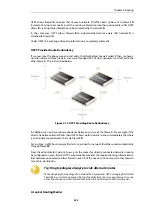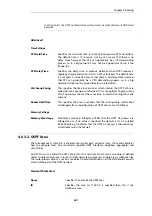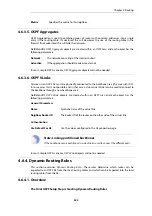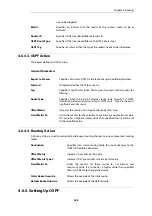
InfTrans Delay
Specifies the estimated transmit delay for the interface. This value
represents the maximum time it takes to forward a LSA packet
through the router.
Wait Interval
Specifies the number of seconds between the interface brought
up and the election of the DR and BDR. This value should be
higher than the hello interval.
Router Priority
Specifies the router priority, a higher number increases this
routers chance of becoming a DR or a BDR. If 0 is specified then
this router will not be eligible in the DR/BDR election.
Note
An HA cluster will always have 0 as router priority, and
can never be used as a DR or BDR.
Sometimes there is a need to include networks into the OSPF router process, without running
OSPF on the interface connected to that network. This is done by enabling the
Passive
option: No
OSPF routers connected to this interface ("Passive").
This is an alternative to using a Dynamic Routing Policy to import static routes into the OSPF
router process.
If the Ignore received OSPF MTU restrictions is enabled, OSPF MTU mismatches will be
allowed.
Promiscuous Mode
The Ethernet interfaces that are also OSPF interfaces must operate in
promiscuous mode
for OSPF
to function. This mode means that traffic with a destination MAC address that does not match
the Ethernet interface's MAC address will be sent to NetDefendOS and not discarded by the
interface. Promiscuous mode is enabled automatically by NetDefendOS and the administrator
does not need to worry about doing this.
If the administrator enters a CLI command
ifstat <ifname>
, the
Receive Mode
status line will show
the value
Promiscuous
next to it instead of
Normal
to indicate the mode has changed. This is
discussed further in
Section 3.4.2, “Ethernet Interfaces”
4.6.3.4. OSPF Neighbors
In some scenarios the neighboring OSPF router to a firewall needs to be explicitly defined. For
example, when the connection is not between physical interfaces.
The most common situation for using this is when a VPN tunnel is used to connect two
neighbors and we need to tell NetDefendOS that the OSPF connection needs to be made
through the tunnel. This type of VPN usage with IPsec tunnels is described further in
NetDefendOS
OSPF Neighbor
objects are created within an
OSPF Area
and each object has the
following property parameters:
Interface
Specifies which OSPF interface the neighbor is located on.
IP Address
The IP Address of the neighbor. This is the IP Address of the neighbors OSPF
interface connecting to this router. For VPN tunnels this will be the IP address of
the tunnel's remote end.
Chapter 4: Routing
344
Summary of Contents for NetDefendOS
Page 30: ...Figure 1 3 Packet Flow Schematic Part III Chapter 1 NetDefendOS Overview 30 ...
Page 32: ...Chapter 1 NetDefendOS Overview 32 ...
Page 144: ...Chapter 2 Management and Maintenance 144 ...
Page 284: ...Chapter 3 Fundamentals 284 ...
Page 392: ...Chapter 4 Routing 392 ...
Page 419: ... Host 2001 DB8 1 MAC 00 90 12 13 14 15 5 Click OK Chapter 5 DHCP Services 419 ...
Page 420: ...Chapter 5 DHCP Services 420 ...
Page 573: ...Chapter 6 Security Mechanisms 573 ...
Page 607: ...Chapter 7 Address Translation 607 ...
Page 666: ...Chapter 8 User Authentication 666 ...
Page 775: ...Chapter 9 VPN 775 ...
Page 819: ...Chapter 10 Traffic Management 819 ...
Page 842: ...Chapter 11 High Availability 842 ...
Page 866: ...Default Enabled Chapter 13 Advanced Settings 866 ...
Page 879: ...Chapter 13 Advanced Settings 879 ...














































